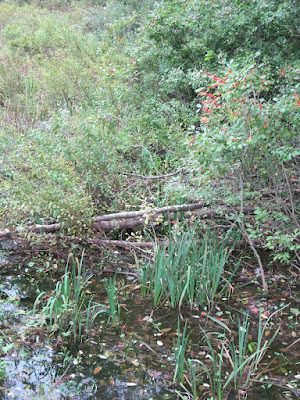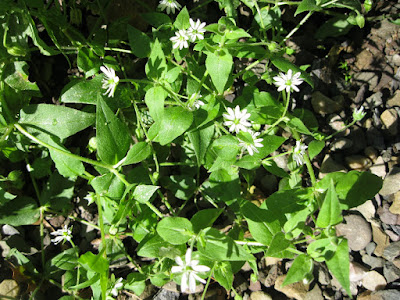Many years ago when I knew little more than which end of a shovel went in my hand, I stopped at a roadside plant stand staffed by a mother and daughter team. Across the road was a sizeable field of plant divisions while potted specimens were offered for sale. An amazing amount of effort had been invested in these plants but at the time I knew nothing about asters and purchased nothing.
These first pictured plants are growing at the northern end of one of our first planting beds. Notice that each flower petal looks like an extended heart with the point attached to the central disc. Yellow pollen marks newly opened blossoms while the reddish ones are developing seed. This plant was mail order purchased so many years ago that we have no memory or record of its varietal name.
October Sky is a named variety that was bred to cover a huge area while remaining rather close to the ground. For some reason the deer do not feed on this plant and those two characteristics make this a must have plant. Its dense foliage shades out the weeds making it as close to a no tending garden plant as exists anywhere.
This wild plant bears a strong resemblance to the plant in the first photo. The mature blossom centers are a different color suggesting two different plants. There is no Goldenrod in the first picture but that does not rule out a second occurrence of the same variety.
Perhaps three years ago several wild plants were moved into a garden bed near the house. Our deer herd greatly appreciated our efforts to provide them with tasty treats. This small purple flowered specimen was given protective cage limiting the deer nibbles to that part of the plant that is above the cage. Left alone this plant would likely reach three feet in height and purple is a favorite flower color here. We are not finished with this one as it deserves a more spacious protected home. We shall put that on the list for next year.

These two colors appear to be growing from the same root mass but excavation would be necessary to be certain. New England asters are a named wild plant that appear in two different colors. The blue colored flowers are recognized as native while the pinkish flowers are seen as a naturally occurring color sport. Frequent divisions have provided us with an impressively sized collection of both plants but they only appear together here near the house and and in one place close to
the road.
These are a wild occurrence of an attractively colored plant. This one deserves a spot in a garden bed but to date that has not happened.
This plant lives on the edge of a manure pile that was provided by a considerate neighbor. Most asters do not have leaves this wide but the heart shaped petals are displayed by many asters. This grows as a ground cover but that may be the result of careless foot traffic.
This picture strongly resembles a plant shown above. The numbers on the photos indicate that they are different plants but they may be the same variety. We would welcome help from a reader that is more familiar with asters.


















